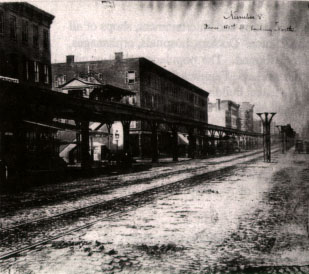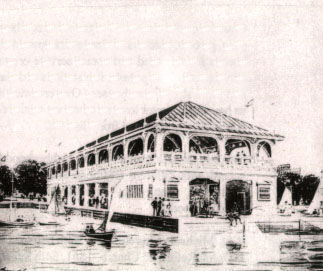|
Churches, schools, social
organizations, places for recreation and entertainment, shops of
all sorts, grocers, butchers, fishmongers opened shop in
Clinton. Doctors, hospitals, orphanages, homes for the aged and
social service organizations formed. The populace pulled in city
services of police patrols, fire stations and sanitation
workers. Families filled clusters of two and three story frame
houses. Overcrowded multiple tenant buildings throughout the
city led its housing inspector to report that one tenth of the
population lived in deplorable housing. He was promptly removed
from his post.
Religion played a central role in
neighborhood life. Ethnic and religious groups worshipped in
accord with different traditions and built churches to suit.
During the second half of the nineteenth century an impressive
number of houses of worship spread through the neighborhood.
- St. Michael's Church, 1857, 34th
between 9th and 10th, largely Italian attendees
- Dutch Reformed Church, 1861, 34th
8th and 9th
- Collegiate Church, 1914, 305-9
West 34; demolished for New Yorker Hotel 1929, now home to
Unification Church of America
- St. Clare's Church for Italians,
1903, 434 West 36th with a school following two years later
- 2nd German M.E. Church, 1913,
346-8 West 40th
- Mission Chapel of Atonement, 1869,
416-18-20 West 41; around 1900 merged into Zion Industrial
School
- Holy Cross Church and school,
1854, 42nd Evangelical Lutheran Church, 424 West 44 [now New
Dramatists]
- The 7th Associate Presbyterian
Church, 1870, 432 West 44 Street, brick late Greek revival style
building which later became home to the famed Actors Studio
- Ganes M. E. Church, 1863,461-3 W.
44
- St. Luke's German Evangelical
Lutheran Church, 1850, 46th between 8th and 9th
- Faith Chapel, 1867, 421 West 46th,
became St. Clement's
- 2nd German Baptist Church, 46th,
in 1889 became part of the assemblage by Wessell, Nickel, Gross
for a new piano factory building, which in turn became an
apartment cooperative in 1980.
- St. Albert's, 47th, primarily
French and Flemish parish members
- Congregation Ezrath Israel The
Actors Temple, 1917, 339 West 47th, the neighborhood's only
Synagogue was established as the West Side Hebrew Association
- German Church of the Assumption of
the Blessed Virgin Mary, 1859, 427 West 49; 1867 school on 50th
- St. James Presbyterian Church
(colored) 3rd site 355-359 West 51. Irvington Hall apartments
built on cleared site 1914
- Sacred Heart parish, 1876, Irish,
51st between 9th and 10th
- Martha Memorial Church, 1886,
419-21 West 52nd
- Second Evangelical Church, 1869,
342 West 53rd
- St. Benedict the Moor, first black
mission church north of Mason Dixon line, founded on Bleecker
Street 1883, moved into a former Protestant church at 342 West
53rd in 1898
- Amity Baptist Church, 1885, 310
West 54th
- St. George Theodorfus Greek
Orthodox Church, 1886, 307 West 54th
- St. Ambrose Church, 1898, 541 West
54th. A religious order now uses this and the adjacent building
as a residence for young working women.
- Deems Memorial Church of the
Strangers, 1927, 309 West 57th
- Trinity Presbyterian Church, 1877,
424 West 57th, also hosts a weekly service by the Church of
South India
- Catholic Apostolic Church 417 West
57th
- St. Paul the Apostle Church, 1876,
59th on 9th, designed by architect Stanford White with
baptistery and a mural by artist John La Farge.
The Catholic Polish National church
which had been housed at 552 West 50th Street moved to 40th off
9th Avenue in 1909. Renamed St. Clemens Mary, with 160 children
attending services, the school continued until 1971. The
Croatian Franciscans took over the 50th Street church renamed
St. Cyril and Methodius. Today the building is a Bysantine
church, its medieval style painting and frescoes magnificently
restored.
 Ninth Ave. Elevated Railroad north from 42nd St.,
showing station at W. 42nd St. Photograph by J.A. Powelson, May
12, 1876. New York Historical Society
Ninth Ave. Elevated Railroad north from 42nd St.,
showing station at W. 42nd St. Photograph by J.A. Powelson, May
12, 1876. New York Historical Society
The astonishing number within one
square mile on this incomplete list clearly indicates the
centrality of church activity in the lives of Clinton residents
throughout its history. Over the years, however, many of the
church buildings have been demolished or converted to other
uses. Only three churches continue their grammar and/or high
schools.
Ethnic and economic groups did not
always mix harmoniously. Racial animosity existed sporadically
and in pockets. During the Civil War Draft Riots of July 1863 a
white mob hanged negroes at 32nd Street and 8th Avenue and women
slashed at three of the bodies. Police routed the mob of 5,000
but it returned later and hung more until artillery was used
against them. Police jailed only 20 men. The mob also burned the
Colored Orphan Asylum between West 44th and 45th Streets on 5th
Avenue. Two white women, Mrs. Anna Shotwell and her niece Ms.
Murray, had founded the home in 1836. Although the fire
destroyed the building, all the children were saved.
 1900's Recreation Pier. Courtesty Department of
Ports, International Trade & Commerce
1900's Recreation Pier. Courtesty Department of
Ports, International Trade & Commerce
In July 1881 a crowd of Irish men in
the neighborhood threw bricks from house roofs at Orangemen
parading up 8th Avenue. A riot ensued. Police summoned the State
Militia which fired on the crowd using real bullets instead of
expected blanks. 30 bystanders were killed, hundreds wounded.
In 1899 when whitemen attacked James
Harris at 41st Street and 10th Avenue, he drew a gun and killed
two of them. A year later, racial tensions erupted into riots in
August. While his wife waited outside, a negro man ducked into a
store on the comer of 41st Street and 8th Avenue to buy a cigar.
Police in civilian clothes arrested the wife. The husband, not
knowing that the man accosting his wife was a police officer,
fought with him. In an ensuing scuffle, the policeman hit him
with a club; the husband slashed him with a penknife, ran and
disappeared. On the day of the policeman's funeral and that
night, hordes of 5,000 young whites 16 to 19 years old mobbed
the streets from 34th to 42nd west of 8th Avenue. Joined by
policemen, they chased negroes dragging them from streetcars or
wherever found to savagely beat them. Police refused to
interfere or protect negroes but instead beat and arrested them,
cries for justice unheeded. In the morning, they did arrest 600
persons. Negroes, refusing to be driven from their homes, formed
a League and hired an attorney who put together a stack of over
50 affidavits describing the viciousness of police.
That blacks continued to live in
Clinton is confirmed by the move of P.S. 6, whose principal was
black, from Broadway by West 35th Street to 41st Street and 8th
Avenue in the late 1800's. During those early years, the city
moved schools and principals to follow the center of the city's
negro population. The city's first negro teacher in a school
which included both blacks and whites was Ms. Susan Frazier. A
graduate of Hunter College in 1888, she waited twelve years for
permanent appointment as a teacher and gained it only after
taking the Board of Education to court.
The 53rd Street blocks from 6th to
9th Avenue between the years 1890 and 1910 were known as the
Black Bohemia. Jack Johnson, the first black heavyweight boxing
champion, comedian Bert Williams and William Sims, the first
black jockey to win the Kentucky Derby three times, lived for a
time in that strip.
A 1930 study by Greater NY Federation
of Churches placed the area's section with largest negro
population around West 58th Street east of 10th Avenue in "San
Juan Hill." The name honored black troops who served in the
Spanish American War. In PS 141, 828 blacks attended out of the
school's 1,104 pupils. Students were drawn from Central Park
West to 12th Avenue, 64th to 55th Street. PS 58 on 52nd Street
west of 8th had 150 black students out of a 750 total. Its area
covered 8th Avenue to the Hudson River, 49th to 59th Streets.
They also counted 50 Puerto Rican students, "a new element just
appearing in the school district." There were no negro churches
below 35th on the west side.
In the 1920's many of St. Benedict
the Moor's parishioners followed a citywide move of blacks to
Harlem in the 1920's. The Spanish order of Franciscans were
assigned to the church and the Church re-dedicated in 1954. Many
of the former members filled the Church for its one hundredth
anniversary celebration.
Catherine Green, born in 1915, lives
on West 51st Street between 8th and 9th Avenue within a block of
her birthplace at 409 West 52nd Street. Her only other two moves
were to apartments on that same block. Her parents arrived on
52nd Street from South Carolina around 1914. Of their 5
children, one boy and 4 girls, three of the girls married
neighborhood boys then left Manhattan. Catherine did not marry.
When her parents both died within a year of each other in the
1930's, the owner of their tenement building kept Catherine and
her brother but the four youngest girls went to an orphanage
because their grandmother was not able to care for them.
Catherine attended PS 58 on 52nd
Street between 8th and 9th Avenues, PS 84 on 50th Street and
Julia Richmond High School on the eastside. She found work in a
hospital, then in a factory as a stamper and pinner on
materials. As each of her sisters reached 16, she took her from
the orphanage and saw to completion of her education. In 1956,
she switched to temporary work at the IRS and from there to full
time at Mangel Stores on 18th Street where she stayed in the
accounting department for 24 and a half years before retiring.
|